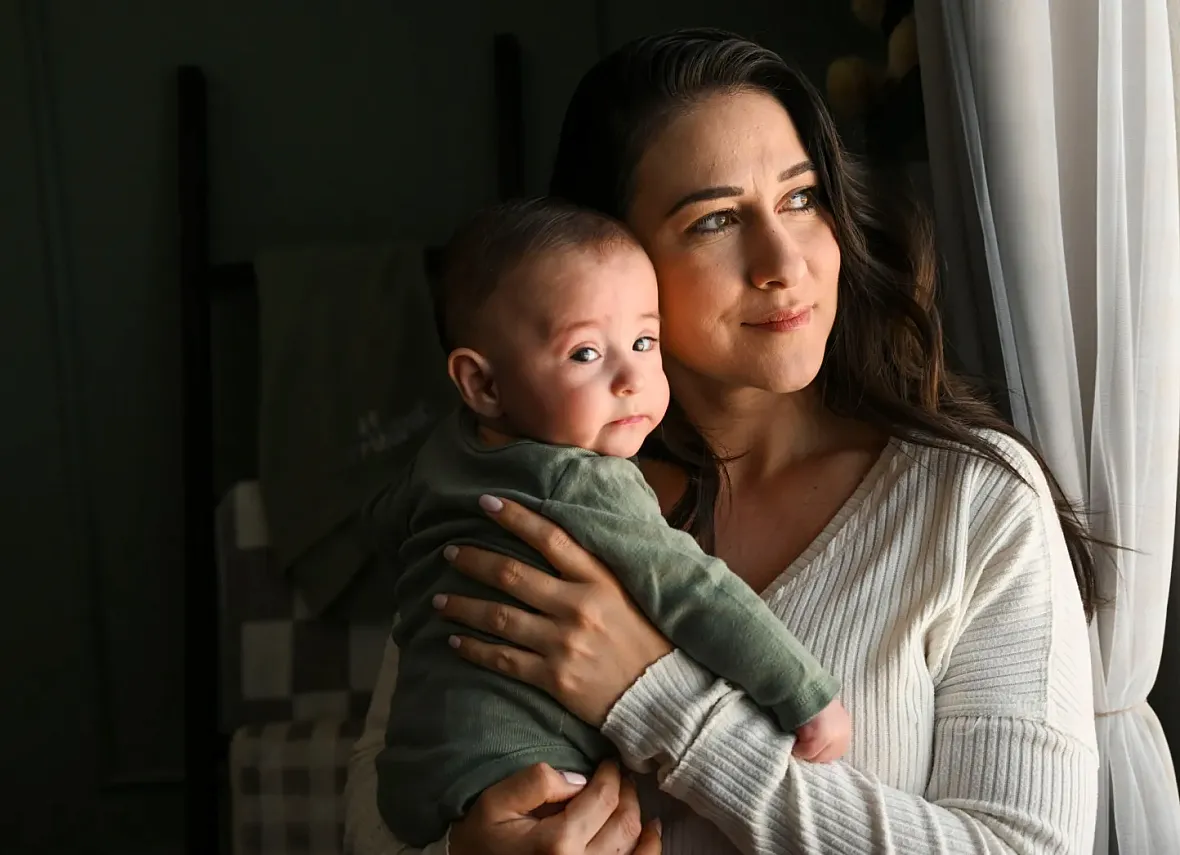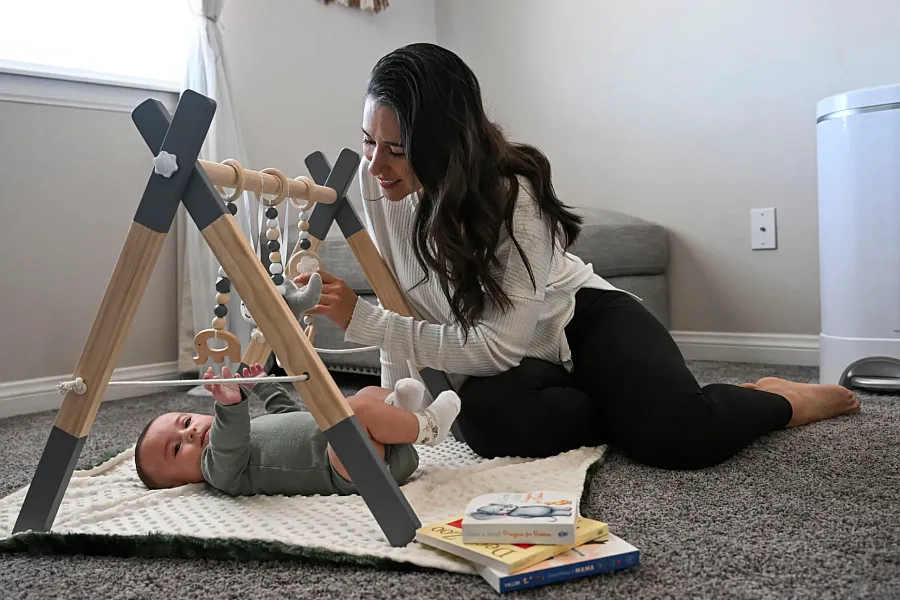Is the Inland Empire a maternity healthcare desert?
The story was originally published by the The Press-Enterprise with support from our 2024 Data Fellowship.

Brittany Montanez holds her son, Alaric Montanez, as they look out the window of their home in Apple Valley on Thursday, April 24, 2025. With limited options for maternal care in the High Desert, Montanez made regular 43-mile trips to Fontana during her pregnancy to see her doctor.
(Photo by Anjali Sharif-Paul, The Sun/SCNG)
When her water broke with signs of blood, Brittany Montanez knew her situation was urgent. She grabbed her bag and jumped in the car to head to the nearest hospital. Though it wasn’t her first choice for medical care, the baby was coming.
But concerns about care and insurance coverage quickly sent Montanez and her husband on a 43-mile trek from their Apple Valley home to Fontana.
“Going into labor that night and having to fight the Cajon Pass down was just so stressful, and it was scary,” Montanez said. “It was honestly very frustrating because this is the only way we have to go down to where we need to get care.”

Brittany Montanez plays with her son, Alaric Montanez, in their home in Apple Valley on Thursday, April 24, 2025. With limited options for maternal care in the High Desert, Montanez made regular 43-mile trips to Fontana during her pregnancy to see her doctor.
(Photo by Anjali Sharif-Paul, The Sun/SCNG)
As a Kaiser Permanente patient, Montanez’s options for maternal care in the High Desert are limited. There’s no Kaiser hospital with labor and delivery services in the area, and though the company partners with another facility in Apple Valley, Montanez wasn’t comfortable seeking care there.
Her story isn’t unusual. For some Inland Empire residents, traveling considerable distances is part of the everyday concerns in their maternal health journey. With few options in rural areas of Riverside and San Bernardino counties, such as Blythe and Barstow — both have just one hospital each — maternal patients may find their next closest options for care are at least a 30-minute drive away from their homes.
By the numbers
According to the 2023 U.S. census and data from the California Department of Public Health, about 21% of San Bernardino County’s 2.19 million residents and 20% of Riverside County’s 2.49 million residents are females of childbearing age, between ages 15 and 44.
Together, the counties have 34 hospitals with emergency services — 23 of which offer maternity care or labor and delivery services for the region’s 958,000 childbearing-age females.
Statewide, of the 325 hospitals with emergency services, there are 214 with labor and delivery services to serve a birthing population of 7.6 million, according to a report from Cal Matters.
That means there are 2.8 hospitals per 100,000 childbearing-age females statewide, but only 2.4 hospitals per 100,000 in the Inland Empire.
That disparity has been underscored in the past two years, when at least two hospitals closed their labor and delivery units — San Dimas Community Hospital in 2023 and Hemet Global Medical Center in January 2025.
That’s a problem, those in the maternal health field say.
“I’m not trying to scare you, but birth is one of the scariest things because it can go bad so quickly,” said Krista Kampe, an Inland Empire native and a neonatal intensive care unit nurse.
“A lot of people get stuck on birth plans, and it goes out the window,” Kampe said. “Anything can change at any moment when you’re giving birth.”
In 2021, there were 21.6 pregnancy-related deaths per 100,000 live births statewide, almost double the rate of deaths per 100,000 births recorded two years earlier, according to state public health officials.
Keeping a close proximity to a hospital at the end of a patient’s pregnancy is crucial, Kampe said, adding that patients should live no more than an hour’s drive from medical care.
“Time is of the essence,” she added, “especially with things like placental abruptions and hemorrhages — when they’re bleeding out and they need a specialist, an operating room, and they need blood.”
Delivering a baby in an emergency room might be an option for patients with no complications, Kampe said.
“But if anything goes wrong,” she added, “the first thing they call is the (obstetrics) team to come get the mom and get the baby.”
Going the distance

Brittany Montanez holds the feet of her son, Alaric Montanez, in their home in Apple Valley on Thursday, April 24, 2025.
(Photo by Anjali Sharif-Paul, The Sun/SCNG)
Concerns over complications during delivery are ultimately what drove Montanez, a teacher, to seek maternity care farther from home in the High Desert.
After battling and surviving uterine cancer that was diagnosed after she experienced a molar pregnancy, a type of non-viable pregnancy, Montanez was accustomed to making the drive through the Cajon Pass to Kaiser Fontana.
She spent months making the long drive for cancer treatments that became fertility appointments post-treatment. More than a year after her cancer treatments, she discovered she was pregnant.
“We just couldn’t believe it. We couldn’t wait to tell the world,” she said.
About eight weeks into her pregnancy, while on a field trip with her second-grade class, Montanez said she began bleeding heavily, prompting a visit to the closest emergency room contracted by Kaiser in the High Desert, Providence St. Mary Medical Center in Apple Valley.
“So they pretty much told me that I was miscarrying and to collect my son, who I didn’t know was a son at the time, (in) a little jar, collect it, give it to Kaiser” at the next appointment, Montanez said.
She returned home and waited a day before eventually seeking care at Kaiser Fontana, where she said urgent care staff found a strong heartbeat from her unborn child.
“We finally got an ultrasound, and it’s good, they’re like, ‘The baby’s fine, you’re not miscarrying,’ ” Montanez said.
Hearing the news that her baby was alive and well gave her relief, she said, but then came the anger and disappointment from the misdiagnosis at St. Mary’s.
In an email, a representative from St. Mary’s Medical Center said the hospital follows the highest safety protocol for all patients.
“We can share that at Providence St. Mary Medical Center, we care deeply about the health and well-being of every patient we serve,” said Matthew Cabe, senior communications manager. “Providence St. Mary offers emergency services in accordance with state and federal law.”
But the experience reinforced Montanez’s frustrations with her access to care.
Though her pregnancy was considered high-risk due to her medical history, Montanez said, things went well until she went into labor just before the 37th week.
“It was Friday night, I think, and I get up from the couch and I just feel like a gush of liquid and I’m like, ‘oh, that’s my water breaking, holy cow.’ I’m freaking out and I pull down my pants, and there’s blood everywhere,” she said.
She ended up going to her closest care option again — St. Mary’s. Despite her previous experiences at the hospital, she wanted to check on the health of her son and, eventually, was told she was preeclamptic, a pregnancy complication that causes dangerously high blood pressure, and needed to be admitted.
Montanez declined to give birth at the Apple Valley hospital and instead chose to make the 43-mile journey to Kaiser Fontana. Her son, despite being born prematurely, is thriving at 8 months old.
How far is too far?
Patients in smaller communities in the farthest regions of the Inland Empire face healthcare accessibility challenges similar to those Montanez experienced.
Maternity care is about more than labor and delivery services — prenatal care can involve numerous appointments, sometimes weekly, depending on the health of the patient and baby.
Maternal patients in Blythe, for example, must travel 45 minutes or more to receive care, according to Deborah Johnson, the Black Infant Health Program coordinator for Riverside County.
“Moms are coming through the desert, coming into Riverside, or closer into Riverside, or going into the state of Arizona for their care,” Johnson said.
The county is working to help patients overcome barriers in accessing care but not without its own challenges, said Curley Palmer, program coordinator for Perinatal Equity Initiative at Riverside University Health System-Public Health.
“Some of the clients that we do have in the desert, we provide gas gift cards and Target gift cards, so that they can get groceries and things like that,” Palmer said. “Well, the gas cards that we provide, it doesn’t do them any good because the gas station that is named is nowhere near them.”
The program is limited in what it can offer clients, however, due to the types of funding it receives. Most of the gas stations in Blythe are locally owned small businesses.
The need for care isn’t likely to diminish in the coming years.
Though regional birthrates declined 6% from 2022 to 2023 according to California Department of Public Health data, the Inland Empire is facing a population boom.
The region is expecting a 20% increase in population in the next 25 years, according to the California Department of Finance, meaning the need for medical facilities to accommodate growing families will grow as well.
Accessibility challenges may be worsened in coming years, as the region braces for cuts in Medicaid, the government health insurance program for the poor and disabled known as Medi-Cal in California.
In May, state public heath department data showed 999,115 Riverside County residents, or 41% of the population, enrolled in Medicaid, and 976,922, or 45% of the population, enrolled in San Bernardino County.
Under the congressional Republicans’ budget reconciliation bill passed in early July, California faces a $24.8 billion cut in federal funding for Medicaid, Gov. Gavin Newsom has said. The cuts could decimate funding for at least five hospitals that serve rural communities in the region, such as Barstow Community Hospital and Hi-Desert Medical Center in Joshua Tree, putting them at risk for closure.
Recognizing the difficulties rural maternal patients experience in traveling for care, Inland Empire-based Sankofa Birthworkers is exploring how it can bring midwife and doula services to impacted communities.
Money from private donors may be the safest option for funding further doula and midwife access, as it may not be subject to the same rules or regulations as government agencies, according to Deidre Medley Coutsoumpos, a doula and founding member of Sankofa Birthworkers.
“There are definitely ways that we feel we could help folks or create more accessibility to individuals,” she said, “if we could just have funding to get something like this launched.”

